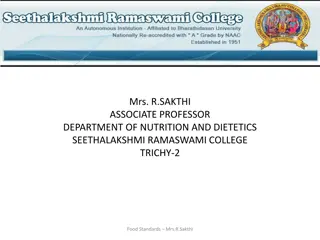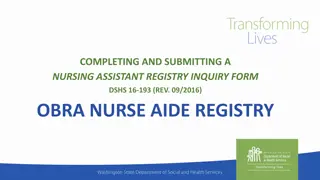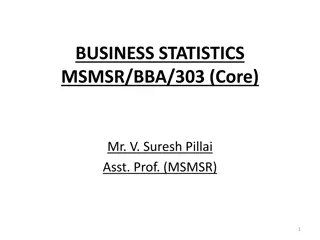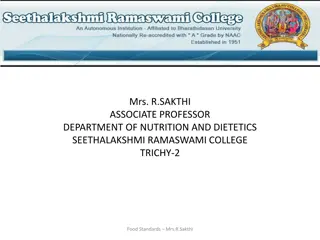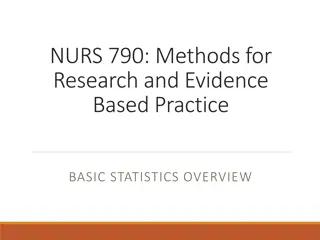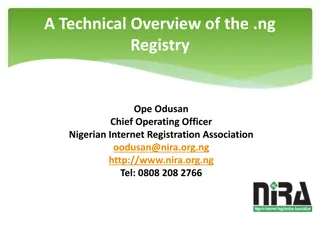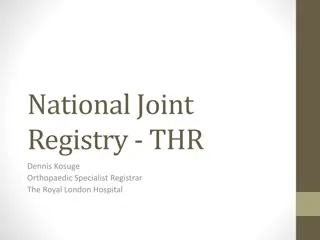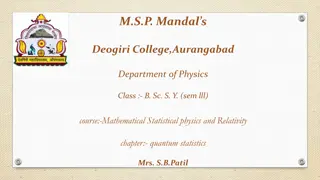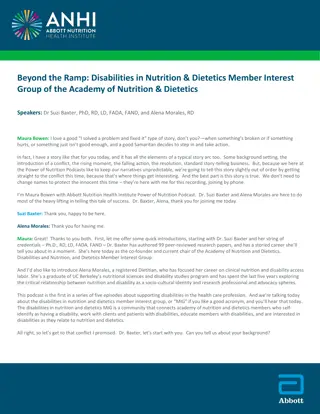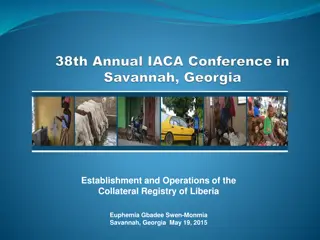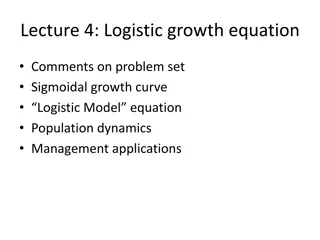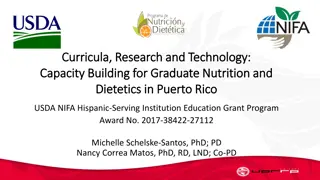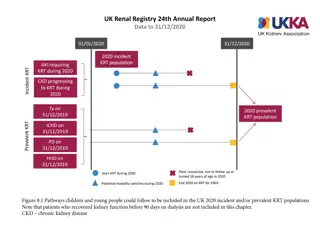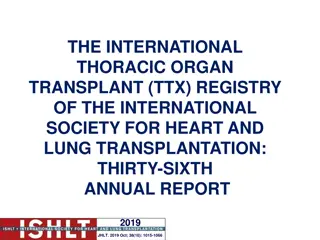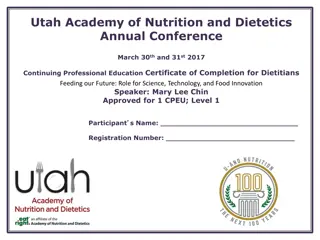Registry Growth Statistics in Dietetics Practice
Tracking the growth of registered dietitians and nutritionists, as well as dietetic technicians, from 1995 to present year. The statistics show trends in new registrants per year, qualifications, and pathways to achieving registered status. Explore the changing landscape of dietetics practice through detailed graphs and images.
Download Presentation

Please find below an Image/Link to download the presentation.
The content on the website is provided AS IS for your information and personal use only. It may not be sold, licensed, or shared on other websites without obtaining consent from the author.If you encounter any issues during the download, it is possible that the publisher has removed the file from their server.
You are allowed to download the files provided on this website for personal or commercial use, subject to the condition that they are used lawfully. All files are the property of their respective owners.
The content on the website is provided AS IS for your information and personal use only. It may not be sold, licensed, or shared on other websites without obtaining consent from the author.
E N D
Presentation Transcript
CDR Update Spring 2016 NDEP Area Meetings 2/24/2025
Registry Statistics Entry-Level Dietetics Practice Audit Updated Entry-Level Dietitian and Dietetic Technician Test Content Outline PDP Practice Competencies Initiative Graduate Degree Registration Eligibility Requirement Resources Online Registration Eligibility System Revision 2
Registry Growth Statistics Registered Dietitian Nutritionist (RDN) 100,000 94,473 89,386 90,000 81,645 80,000 73,155 67,406 70,000 59,269 60,000 50,000 40,000 30,000 20,000 10,000 0 1995 2000 2005 2010 2013 2015 YTD 4
Registry Growth Statistics Nutrition and Dietetics Technician, Registered (NDTR) 6,000 5,535 5,511 5,129 5,060 5,000 4,618 4,239 4,000 3,000 2,000 1,000 0 1995 2000 2005 2010 2013 2015 YTD 5
New Registrants per Year Registered Dietitian Nutritionist (RDN) 4,500 3,945 4,000 3,665 3,615 3,500 3,229 2,888 3,000 2,733 2,664 2,500 2,000 1,500 1,000 500 0 1995 2000 2005 2010 2013 2014 2015 6
New Registrants per Year Nutrition and Dietetics Technician, Registered (NDTR) 700 635 632 623 605 600 500 416 400 300 200 185 200 100 0 1995 2000 2005 2010 2013 2014 2015 7
2009 2016 8
Dietietc Technician Pathway III to Registered Dietitian Status 2009-2015 400 370 350 299 300 241 250 200 160 150 100 82 50 10 1 0 2009 2010 2011 2012 2013 2014 2015 9
2015 Entry-Level Dietetics Practice Audit 10
Why A Practice Audit ? NCCA standards for Accreditation of Certification Programs. The certification program must analyze, define, and publish performance domains and tasks related to the purpose of the credential, and the knowledge and/or skill associated with the performance domains and tasks, and use them to develop specifications for the assessment instruments. The certification program must employ assessment instruments that are delivered from the job/practice analysis 11
CDR 2015 Entry-Level Dietetics Practice Audit Task Force CLINICAL / COMMUNITY Paula Kellogg Leibovitz, MS, RD, CDE, CD-N Chair Molly Gee, MEd, RD, LD Kathryn K. Hamilton, MA, RDN, CSO, CDN, FAND Jin Kuo, MS RDN Feon Cheng, MPH, RDN Jeri Finn, MS, RD Khursheed Navder, PhD, RDN, FAND Aspen Perovich, MS, RD, LD Megan Sexton, MS, RD, LD Karen Brtko, DTR Le Greta Hudson, MS, RDN, LD, CDE Julie Mallory, MS, RD, LD FOOD SERVICE/MANAGEMENT Kevin Sauer, PhD, RD, LD Sharon Doughten, MS, RD, LD Jennifer (Gardner) Tatro, RD Jeffery Ketcham, MBA, RD Isolda Lyon, RD Jodi Weber, DTR ACEND REPRESENTATIVE Kathleen Creedon, RD CONSULTANTS Dick Rogers Leanne Worsfold Kelly Griswold Juli Goerend 12
What is a Dietetics Practice Audit? Quantitative measure of what dietitians and dietetic technicians actually do in practice. Comparisons of those measures with previous practice audits Identification of distinctions between entry-level RDN and NDTR practice Empirically validate adequacy of entry-level operationally defined in the past as the first three years following registration 13
Dietetics Practice Audits Update ACEND Dietetics Education Program Accreditation Standards Update Examination Content Outlines (Test Specifications) 14
For each activity statement, respondents were asked to indicate: way(s) involved: not involved / perform under supervision / perform with supervision / supervise/manage frequency (if involved): daily / weekly / monthly / less than monthly risk (if involved): very low / low / moderate / high / very high 15
Study Methodology Pre-notification Postcard Personalized invitation letter Survey Reminder Postcard E-mail Reminder Follow up Survey Reminder Postcard Reminder E-mail Gift Card Incentives 16
Sampling Plan/Response Rate RDN Sample - 3,400 (registered up to 5 years) 53% Response Rate NDTR Sample 2,100 (registered up to 5 years) 49% Response Rate 17
NDTRs PIII v PI : Setting(s) 0% 20% 40% 60% 80% 100% 34% acute-care - inpatient 37% 6% acute-care - outpatient 4% 3% 2% ambulatory/outpatient care 17% LTC or extend care facility 27% 5% assisted living facility 8% 8% rehab facility 15% 7% 6% congregate dining NDTRs 1-5 PIII 2015 community or public health program 19% NDTRs 1-5 PI 2015 16% 9% government agency 7% 4% 4% private practice 5% 4% wellness center/health club college/U/teaching hospital faculty 10% 5% + others base: practitioners (multiple CDR 2015 Practice Audit 20
NDTRs PIII v PI: Demographics 0% 20% 40% 60% 80% 100% 19% location: Northeast 35% 25% location: Midwest 31% 21% location: South 15% 35% location: West 19% NDTRs 1-5 PIII 2015 NDTRs 1-5 PI 2015 highest degree = MS+ 14% 6% 86% highest degree = BS 33% 0% highest degree = AS 61% 11% age 40+ 49% 66% age <30 23% CDR 2015 Practice Audit 21
Entry-Level Validated as Three or Less Years in Practice 22
Test Specification Development Task Force - NDTR Clinical/Community Practice Food Service Systems Management Paula Leibovitz, MS, RD, CDE, CDN, Chair Margaret Garfoot, MS, RD Karen Brtko, DTR Isolda Lyon, RD, LDN Molly Gee, MEd, RD, LD Victoria Rethmeier, MS, RD, CDE, LMNT Joann Gruner, MBA, RD, LD Kevin Sauer, PhD, RD, LD Christine Hartney, MS, RD, CNSC Jodi Weber, DTR Kathryn Hardison, MS, RD Coleen Liscano, MS, RDN, CSP, CDN, CDR/Pearson VUE CNSC, IBCLC Khursheed Navder, PhD, RD, FAND Kay Manger Hague, RD CDR Aspen Perovich, MS, RD Julie Miles, - Pearson VUE Becky Sulik, RDN, CDE, LD Xinrui Wang Pearson VUE Holly Trueblood, DTR Juli Goerend Pearson VUE 23
Test Specification Development Task Force - RDN Clinical/Community Practice Paula Leibovitz, MS, RD, CDE, CDN, Chair Feon Cheng, MPH, RDN Robin Evans, MPH, RD Molly Gee, MEd, RD, LD Laura Romig Gollins, MBA, RD Kathryn Hardison, MS, RD Kathryn Hamilton, MA, RD Young Hee Kim, MS, RD, LDN, CNSC Rachel Kossover, MPH, RDN Coleen Liscano, MS, RDN, CSP, CDN, Foodservice Systems Management Kathryn Lawson, MS, RDN, CD Jeffrey Ketcham, MBA, RD Mary Beth Ohlms, MEd, RD, LDN Kevin Sauer, PhD, RD, LD CDR/Pearson VUE Kay Manger Hague, RD CDR Julie Miles, - Pearson VUE Xinrui Wang Pearson VUE Juli Goerend Pearson VUE CNSC, IBCLC Khursheed Navder, PhD, RD, FAND Aspen Perovich, MS, RD Bruce Rengers, PhD, RD Becky Sulik, RDN, CDE, LD Pauline Williams, PhD, MPA, RDN, CD 24
Translating the Practice Audit Results into Test Specifications Involvement Frequency Risk 25
NDTR Test Specifications 2012 2017 I. Food and Nutrition Sciences A. Principles of Food Preparation B. Food Composition C. Principles of Basic and Normal Nutrition 10% I. Nutrition Science and Care for Individuals and Groups A. Principles of Basic and Normal Nutrition B. Screening and Assessment C.. Planning and Intervention 44% II. Nutrition Care for Individuals and Groups A. Screening and Assessment B. Diagnosis C. Planning and Intervention D. Monitoring and Evaluation 34% D Monitoring and Evaluation II. Food Science and Food Service 24% A. Menu Development B. Procurement and Supply Management III. Principles of Education and Training A. Assessment and Planning B. Implementation and Evaluation 7% C. Food Production, Distribution, and Service D. Sanitation, Safety, Facility and Equipment IV. Foodservice Systems A. Menu Development B. Procurement and Supply Management C. Food Production, Distribution, and Service D. Sanitation, Safety, and Equipment 22% III. Management of Food and Nutrition Services 32% A. Human Resources B. Finance and Materials C. Marketing Products and Services D. Management Principles and Functions V. Management of Food and Nutrition Services A. Human Resources B. Finance and Materials C. Marketing Products and Services D. Management Principles and Functions E. Quality Processes and Research 27% E. Quality Processes and Research 26
RDN Test Specifications 2012 2017 I. Principles of Dietetics A. Food Science and Nutrient Composition of Foods B. Nutrition and Supporting Sciences C. Education and Communication D. Research E. Management Concepts 12% I. Principles of Dietetics A. Food Science and Nutrient Composition of Foods B. Nutrition and Supporting Sciences C. Education, Communication and Technology D. Research Applications 25% II. Nutrition Care for Individuals and Groups A. Screening and Assessment B. Diagnosis C. Planning and Intervention D. Monitoring and Evaluation 40% II. Nutrition Care for Individuals and Groups A. Screening and Assessment B. Diagnosis C. Planning and Intervention D. Monitoring and Evaluation 50% III. Management of Food and Nutrition Programs and Services A. Functions of Management B. Human Resources C. Financial Management D. Marketing and Public Relations E. Quality Management and Improvement 21% III. Management of Food and Nutrition Programs and Services A. Functions of Management B. Human Resources C. Financial Management D. Marketing and Public Relations E. Quality Improvement 21% IV. Foodservice Systems A. Menu Development B. Procurement, Production, Distribution, and Service C. Sanitation and Safety D. Equipment and Facility Planning 14% IV. Foodservice Systems A. Menu Development B. Procurement, Production, Distribution, and Service C. Sanitation and Safety D. Equipment and Facility Planning E. Sustainability 17% 27
Registration Eligibility Processing System (REPS) Streamlined Process 28
REPS Goals Respond to program director consensus regarding CRMS efficiencies. Improve the application experience for program directors Enhance student processing accuracy and efficiency Improve reporting capabilities Provide for CDR primary source verification of degree completion 29
Practice Competency-based Professional Development Initiative 30
Educator Tool - Kit Goal Wizard tutorial Dream Wizard demonstration YouTube video Lesson plan Recorded presentations FAQ Key messages 31
Graduate Degree for Entry-Level Eligibility Effective January 1, 2024 32
CFP Visioning Report CFP Recommendation #1 Elevate the preparation for the future entry-level RDN to a minimum of a Graduate degree from an ACEND- accredited program. CDR Motion April 2013 Move to change the entry-level registration eligibility education requirements for dietitians beginning in 2024 from a baccalaureate degree to a minimum of a graduate degree. All other entry-level dietitian registration eligibility requirements remain the same. CDR s Motion does NOT require that the graduate degree be granted by an ACEND accredited program. 33
Eligibility Criteria for RDN Current 2024 Baccalaureate degree from a US accredited college or university or foreign equivalent ACEND-accredited DPD program ACEND-accredited supervised practice (coordinated program, dietetic internship, or ISPP) Graduate degree from a US accredited college or university or foreign equivalent ACEND-accredited DPD program ACEND-accredited supervised practice (coordinated program, dietetic internship, or ISPP) 34
Graduate Degree Registration Eligibility Requirement Effective January 1, 2024 This Date Does Not Impact The ACEND Standards Development Process 35
Eligibility Criteria Exception Current RDNs Not Required to Obtain Graduate Degree 36
Registration Examination Content Outline The Content Outline Will Change Over Time Based on Dietetics Practice Audit Results 37
Next Steps On-going communications to stakeholders Review and update of registration eligibility systems and information 38
CDR Scholarships/Fellowships Over One Million Dollars in CDR Scholarships Awarded Since 2011 Annually 10 -$10,000 Doctoral Scholarships 20 - $5,000 Diversity Scholarships 4 - $10,000 PhD to RD Fellowships 39
CDR Website Resources Preceptor Online Training Course Coming soon . Assessing Prior Learning Online Course


